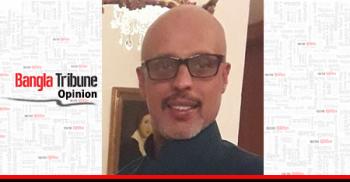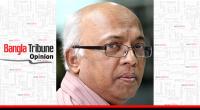 The ignominy is now public knowledge — according to Economic Intelligence Unit, EIU, Dhaka is the second least livable city in the world with the dubious distinction of being the worst going to war ravaged Damascus. While it’s no surprise that Dhaka is not the ideal city to be in, the fact that it’s ranked just after a war torn city, has puzzled a lot of people.
The ignominy is now public knowledge — according to Economic Intelligence Unit, EIU, Dhaka is the second least livable city in the world with the dubious distinction of being the worst going to war ravaged Damascus. While it’s no surprise that Dhaka is not the ideal city to be in, the fact that it’s ranked just after a war torn city, has puzzled a lot of people.
Well, just to give you an example, if someone has a heart attack in Elephant Road and has to be taken to a hospital fast, let’s say around 7:30 in the evening, then getting the patient to the emergency may take hours, unless of course it’s a Tuesday, when this area and adjacent ones are closed for business. That means, someone with heart complications has to pray that if there is a sudden health issue, it should be Tuesday. But then, we cannot control a sudden health emergency.
The horrific truth we have to accept is that one may actually die on the way to the hospital and that’s enough to make Dhaka an unlivable city.
But we all know the problems of Dhaka, at least the ones that make it unglamorous.
For those who grew up here and saw the placid, sparse and tranquil look of the late 70s, 80s and early 90s, this grotesque metamorphosis is hard to accept.
If you have not seen that dreamy Dhaka, then here’s a nostalgic dive into the city that was sheer magic with untarnished romanticism.
Gulshan: not a glitzy hell-hole but a calm suburbia
First, allow this to sink in: Gulshan area was not even considered main Dhaka city in early 80s. It was outside Dhaka, a place where people went for long drives in the evenings and to check out the DIT-1 supermarket. At that time, this market sold used furniture by outgoing foreigners/diplomats, second hand books and all the fancy condiments we now buy from the local stores.
Believe me, mayonnaise was only available at certain shops in Gulshan 1 and 2 because residents in others parts of town either didn’t know what it was or, had no use for it.
‘Burger’ was seen in Archie comic books only. Fast food meant singara, samosa and hot patties. If a guest came to our homes, the food offered was hot patties from the local store and Coke or Crush, the latter being an orange cola. For some time, the preferred drink was Apple Cidra!
From Gulshan 1 to 2, the road was covered by large trees on both sides; leaves rustled as cars passed at irregular intervals. After seven in the evening, the silence on the road was haunting.
The rickshaw fair from 1 to 2 was Tk 2 in the early 80s.
Gulshan was the residential area of the affluent and the foreigners stationed here. However, people from other parts of town also came to try the restaurants.
In Gulshan 1, there was Cathay with the revolving table, Leung Hung in Gulshan 2 and the city was abuzz when an upmarket fast food joint: ‘Kintu Ki’ opened. Burgers were available at Tk 75 – in a time when one person’s pocket money for the entire week was Tk 50.
Beyond Gushan-2 were villages, totally rural areas. Even in early 90s, Kalachandpur was like a village with very few full concrete homes.
Near Baridhara, there was a swamp area where people went to hunt birds or trap fish.
People walked on the pavement, water clogging was rare
In the evening, plenty of people took their daily exercise by walking to a friend’s house, wearing Khadim hockey boots or BATA canvas shoes. In the mid-80s, variation in shoes came when Elephant Road markets started to sell imported trainers from Thailand: Nike, Pan and Roadster.
Prices of top quality shoes went upto Tk 1,000 – a huge amount and parents usually gave a precondition to their wards of good grades at school for consenting to buy a pair.
Another condition was: finish all the questions papers from Globe or Ideal’s test papers before SSC and you may get a pair!
In monsoon, water-clogging was rare. At least on Elephant Road, we never saw stagnant water because there was a canal just at the edge of Hatirpool Bazaar which ran upto where the Sonagaon Hotel now stands.
Many homes had ponds and, hence, water had some where to end up without causing inconvenience.
Countless individual homes had small gardens with a variety of fruit trees; in the evening, residents either went to the roof to have their tea or sat in the garden.
It was a daily ritual to refresh the mind. Hot home-made food was served; discussion flowed from politics to the hottest TV show of the time: Hawaii Five O, The Saint, The Fugitive, Gemini Man, Man from Atlantis or The Persuaders.
The ‘chhaad-culture’ or roof culture is gone; ask mid-forties couples now and many will confess that their first encounter was from one roof to the other, with love letters thrown over to both sides.
A time of unsullied ethos and plenty of romanticism
The decades after independence saw Bangladesh grapple with a plethora of economic woes. Yet, in these times of austere living with the common middle class household income hovering between Tk 10,000 and 15,000, there was an untainted sense of satisfaction.
Almost all families were bound by a similar sort of cultural and social habits – work during the day, late afternoons preserved for long chats, evenings spent in front of BTV and its marvelous programmes plus eating out once every three or six months.
Weekends meant going to the movies or theatre – latest films hardly came but people didn’t mind. Sometimes, Hollywood B movies, Hong Kong subbed films or old classics became all the rage: “Kill and Kill Again”, “Our Man Flint”, “Love and Bullets”, “Guns of Navarone”, “Dirty Dozen”, “Deadlier than the Male”, “Man called Tiger”, “One armed Boxer” and lot’s more.
When Bruce Lee’s “Enter the Dragon”, a 1973 movie, came to Dhaka in early 1984, the city’s main focus was around the Modhumita Cinema Hall.
A Dress Circle ticket, priced at Tk 24 went for Tk 400 in the black market. “Enter the Dragon” also triggered a martial arts craze in the country which saw Dojos springing up everywhere. At St. Joseph’s we saw the poster of Yuree, a martial arts expert, who had been trained in Tibet.
A young lad’s most desired item was a pair of Nan Chuks or getting in to a Karate school.
Eating out inevitably meant going to a Chinese restaurant serving highly Mughlai version of Chinese dishes. On Elephant Road, the most popular was Beijing, run by Abahani footballers Choto Kamal and friends, at the Balaka Cinema Hall there was another famous restaurant called: Bang Chin with the image of a bald man as its mascot. Some of the restaurants like Ming House and Shanghai were run by Chinese people. My personal favourite was Whang Ho on the Paribagh Road.
In Gulisthan there was Chou Ching Chao – the first oriental food place to open prior to independence.
In that Dhaka, residents spent leisure time reading books, magazines and journals. We smuggled in Masud Rana books in false covers so parents wouldn’t find out. Rana was forbidden since his rather laissez faire approach to sex was deemed outrageous and, morally depraved by most guardians.
Most parents were suspicious of those who read Masud Rana and the oft repeated line by many mothers admonishing their sons for mixing with the wrong boy: “Don’t mix with him, he reads Masud Rana!”
Ironically, most parents also read Rana, though surreptitiously.
Thinking back in retrospect, this concern about reading Rana and being influenced by liberal views about sex is indicative of an age when guardians believed that certain matters should be kept away from young people until they reached a certain age.
With sociologists now calling for parents to monitor their children’s activities in the net, we are actually endorsing the innocent concern of the lost decades.
Back in the 80s, reading for pleasure was present in all middle class homes in the city which inculcated in the young a set of simple but essential virtues.
Materialism was not blindly pursued by most; instead, happiness with ideals was the main goal. That was a period when ecstasy among the young came in the form of yellow and black paper tiger masks, a tin made steamer running on kerosene, Bonalim toffees, Mimi chocolate bars, Kojak lollipops or, filling plastic syringes with water and attacking someone with a sudden spray.
For teenagers the ultimate gift was a small post card with the picture of Lee Majors as Six Million Dollar Man or Farrah Fawcett in her golden hair and a beaming smile.
Going anywhere by rickshaw hardly took half an hour, traffic jams usually formed on Elephant Road during Eid time, which people enjoyed as part of Eid novelty.
Buses drove at moderate pace, there wasn’t any rush anywhere, either at home, at the work place or, even at school.
Children played on fields every afternoon while elders reflected on slow paced sensual spirit of Dhaka, sipping tea on the roof.
Simply put: we were residents of a city blissfully left behind in time.
In Black and white TV sets our fantasies had an outlet and lights were out in all homes by 11pm. Late-night movies were only for adults – uncomplicated rules but Dhaka was an arcadia. A sleepy city with some old fashioned values without the frenetic pace.
In our quest to become fast, we lost all of them, and, in a mad frenzy to bring changes without considering long term implications, the serene city is now an insane asylum.
Well, for those like us who experienced the best period of this town, there is always the chance to put out the light, and reminisce with the famous song: “Chole amar cycle hawar bege uira uira…Dhaka shohor dekhmu aaj duijone ghuira ghuira…”
Towheed Feroze is a News Editor at Bangla Tribune and teaches at the Dhaka University

